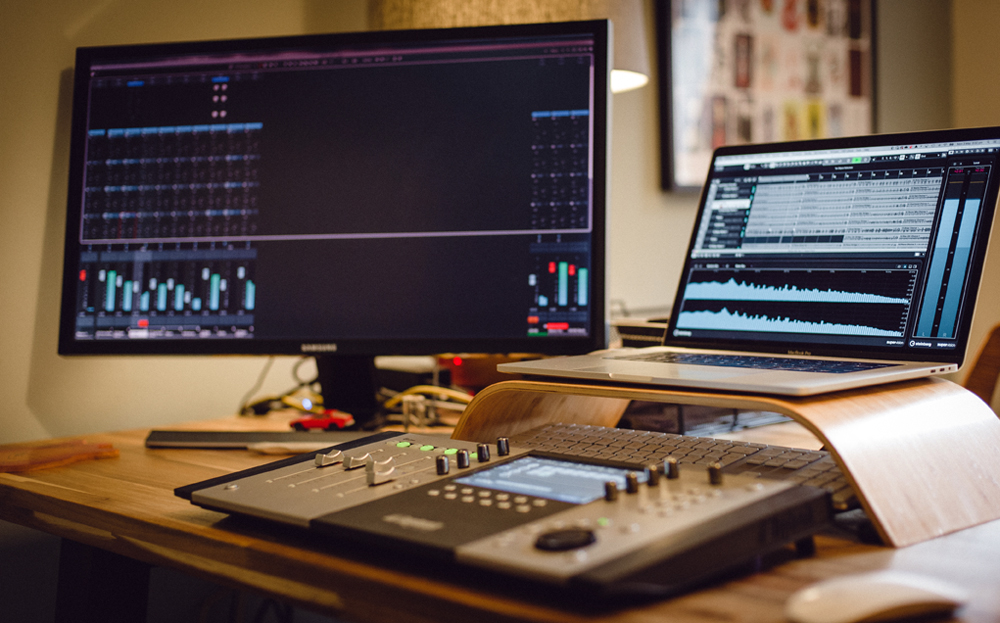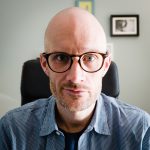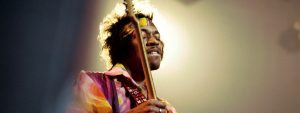Julian Ward: The Three Simple Principles That Helped Me Enjoy Recording at Home
by Julian Ward
Where, how, and why I enjoy playing guitar has been constant for years—on stage, under-rehearsed, and all in the name of getting the audience dancing or singing along. I don’t write songs and I’ve never enjoyed recording at home, so for me when there are no gigs, there’s no reason to play guitar.
Faced with a surfeit of spare time over the last year and zero chance of playing live, but knowing that “playing my guitar” was one of the things I’d like to spend some of that time doing, it was clear I needed to find a new way to get inspired.
The journey that the search for inspiration ended up taking me on has been enjoyable and quite unexpected. I’ve experimented with gear I haven’t been interested in before, tried techniques I’ve shied away from in the past, and even taken the steps towards practising and developing the skill to actually sing and play guitar at the same time. It’s shown me a new way to enjoy playing guitar that I haven’t been able to crack in more than 30 years and taught me a few things I can apply to other areas.
It’s all based around three things.

First: the “what” doesn’t really matter. Faced with my “what” (live gigs) being totally impossible, I had no choice but to figure out my “why”—and for me, it turns out that’s something around using music to provide a source of fun, entertainment and, if I’m really lucky, a little bit of inspiration to others. I discovered this while trying to learn to sing and play songs on my acoustic guitar in my home office; sat at the other side of the desk, it turned out to be actually quite entertaining for my wife. At the same time, I started recording little Instagram videos as part of the Yamaha Social Riffing campaign—where players post a lick or solo to learn as a catalyst to making something new. My social media presence is hardly sufficient to risk me quitting my day job to become an influencer, but the handful of comments and likes on my videos did the job; somehow, somewhere, it was probably making someone smile or think about picking up a guitar.
Second: the “how” makes a difference, certainly in terms of the gear you use. For someone who works for an instrument manufacturer this may seem a little self-serving, but my view of getting your setup right hasn’t really got anything to do with spending a fortune on the latest all-singing, all-dancing gear—it’s about making what you have work as hard and as well as possible.
This realisation came from a conversation with a friend about workflow and how fighting to resolve a driver conflict in his DAW had killed his creativity. It’s what Robert Pirsig describes as a “gumption trap” in his book Zen and The Art of Motorcycle Maintenance: something that saps your energy and results in a loss of motivation and enthusiasm.
Assuming your “why” is sufficiently inspiring to get you to sit down with whatever gear you have to make some music, setting yourself up to avoid gumption traps should be a high priority. Helpfully, I believe they arrange themselves into two categories—technical and creative—and approached right, I’ve found that both can be quite rewarding to work on.
Technical gumption traps are the easy ones to spot: the driver conflict that won’t let that plugin launch, the mysterious earth hum, the broken cable, the forgotten method to assign that input to that channel in that particular piece of equipment or software. The important thing here is to understand that this crucial bit of making music is not separate from actually making music. This is not boring busywork to be avoided—it’s laying the technical foundation on which you’ll build your creative walls, the final result being your masterpiece of a house. Think of yourself as the studio engineer maintaining the console during downtime between sessions so you don’t have to fix a crackly fader or sticky switch in the middle of a perfect take. Or the mechanic tuning the car before a race so when the driver hits the throttle on the home straight it responds perfectly. The race may be the focal point, but winning depends on a lot more than just the time between the green light and the chequered flag.
Creative gumption traps can be much harder, because these are far more personal and often don’t make themselves obvious. These are the things that stop you getting into the zone and losing yourself in the flow, the invisible and indefinable forces that align to conspire against a perfect take.
If you’ve ever had a great idea that you ceased to care about halfway through trying to capture it, you’ve probably run into a creative gumption trap. The specifics of these aren’t important, the key here is to understand what makes a difference to you. A big one for me is software verses hardware, what product designers would call “workflow” or “user experience”—a lack of knobs, buttons, faders, and dedicated displays saps my creativity; mixing “in the box” leaves me cold.

I’ve realised that I have to be quite careful about where I can take advantage of the power and cost-effectiveness of software, and where only hardware will do. Over the last year that’s led to me figuring out how to set up my Helix Rack as the I/O for my DAW system and thereby avoid the need to buy a standalone interface, building a tiny rack to house a couple of bits of outboard gear, and dusting off an old control surface so I have faders to mix on.
This set of tactile interfaces has transformed my attitude towards creating music at home. For the first time ever, I actually want to sit down, record, and mix something at home. But it’s not all vintage outboard and moving-fader throwbacks to a ’90s studio—several years late to the party, I also started building my own backing tracks from loop kits, something I’ve watched others do for years but never been able to summon the enthusiasm to actually start.
Avoiding gumption traps will probably involve spending some money, but the moral of the story is to learn how to spend wisely. Sometimes that will be on the latest bit of tech that everyone’s raving about, sometimes it’ll be on a flatpack rack and a tin of paint so you can finally hook up that old gear without having cables trailing all over the floor, sometimes it’ll just be on replacing that crackly old cable. Which leads me to the final point …
Third: focus on achieving peace of mind. Things get a little hippy-dippy at this point, but stick with me.
The root of all good work is peace of mind. According to Pirsig, “Peace of mind produces right values, right values produce right thoughts. Right thoughts produce right actions and right actions produce work which will be a material reflection for others to see of the serenity at the center of it all.”
I take this to mean that if you’re somehow niggled by something, anything, even if it’s indiscernible, you won’t do your best work. Just like the creative gumption traps, exactly what that looks like is highly personal, but once you spot it and can start to work on it, things get really rewarding, really fast. The easiest example is the physical space you work in: are you a neat person or an organised-chaos person? Have you ever tried to do good work in the opposite atmosphere? How did that work out?
This is a good place to start working out the peace of mind muscle. You can rearrange your space for little or no money, and see what helps. Approach it like a home decorating project. Look at other people’s spaces that you find appealing and try to reproduce bits of them. Do more of what feels good and less of what doesn’t. It’s a process, so don’t expect to “fix” it in one go. If it sounds a bit flaky and frivolous, think of pro studios—how many of them have some kind of cool lighting instead of fluorescent overheads?

For me, the biggest drivers of peace of mind are reducing distraction and increasing my sense of control. That means working in silence when I’m writing this post—but when I’m recording and mixing it means uncluttered surfaces, not being able to see a mess of cables, and mixer controls feeling accessible. Cubase 11’s channel strip view is great for this—but be warned, a big monitor is essential to make the most of it. The hardware outboard gear with big, dedicated displays helps too. The surprising part that probably brings me the most joy? The single USB cable that runs, almost invisibly, around the corner from my computer to my new outboard rack. It’s a thing of tidy wonder.
The specifics are different when I’m editing video, cooking, or working on my mountain bike—but the principle is the same. I’ve realised that if I have peace of mind I’ll do good work and, over time, I’m learning what gives me that peace of mind. Working on those things is surprisingly rewarding.
If we’re fortunate, the need to find inspiration in an uninspiring situation will gradually recede as 2021 progresses and our horizons open back up. But whether getting inspired and creating stuff is something you depend on to pay the bills, or something you do for pleasure, having an approach to seeding and supporting that creativity might just be helpful, even when everything’s possible again.
I wasn’t looking for them, but three simple principles showed up this year in response to me wanting to play guitar more while facing the frustration of having my usual outlet totally cut off: try to understand why you play music to help you see what to do; look for ways you can tweak and optimise your setup to avoid gumption traps that stop your creative momentum; find out what constitutes peace of mind for you, then focus on things that help you achieve it as the first step to doing good work. I’ve applied them to making music and, surprisingly, enjoyed playing guitar more this year than I have for a while. Who knows, next year I might even write a song…

Julian Ward is Global Guitar Strategy Manager for Yamaha Corporation. He has been playing live shows since he was 14, mixed hundreds of live gigs, and engineered records in commercial studios and converted houses.
Related posts
Leave a Reply
You must be logged in to post a comment.
By submitting your details you are giving Yamaha Guitar Group informed consent to send you a video series on the Line 6 HX Stomp. We will only send you relevant information. We will never sell your information to any third parties. You can, of course, unsubscribe at any time. View our full privacy policy





Much truth in what you say here and that focus on WHY you play guitar (or whatever else) is pretty critical. That will most likely drive all else you do.
One major trap I forever fall into is chasing my sound at the expense of productivity and creativity. Happens in both hardware and software realms. I happen to use the Line 6 POD HD Pro rack mount unit, which has a level of complexity that allows you to spend hours just fiddling and tweaking.
Eventually, instead of being happy with what it can do (most of which is great), I end up frustrated by what it can’t do. Mostly this was in the area of Cab and Mic emulations. So I bought a Joyo Cab Box unit and included that on the FX loop to allow me to load whichever cab IR’s I felt like.
Well guess what happened, I then spent forever playing around with the IR options and all the settiings in the Joyo Cab Box, which were also pretty complex given that there is much available to adjust at the power amp, cab/mic and EQ stages in that little box alone!
Add to that the vast differences in sound you get when running the gear through a power amp + guitar speaker rig verses direct into the DAW and you can spend the rest of your life just fiddling with sounds and not getting on with creating music.
So I forever keep trying to remind myself that many of the greatest songs ever recorded have pretty ordinary guitar tones when you listen closely to just the individual guitar parts. Yet when they sit in the mix with all the other instruments, they are just fine.
For me then, the trick here is to perhaps accept that near enough is actually good enough sometimes.
How many people are really going to care that you spent hours and hours just honing that guitar tone. Mostly they just want to listen to a song they like.
So I will keep reminding myself of that, get on with playing and having fun and, hopefully, produce some decent music.
Cheers, Grant
ABYHNHO – (Australian melodic metal project)
This is excellent wisdom and ZATAOMM application. I have been dealing with this same set of hurdles.
Another to add to the list is the fatigue of being a marketing/data worker by day and a “get me away from a computer screen” person by night.
I will be thinking about aligning my “why” with my application of musicality to find reasonable ways to incorporate both.
Again, thanks a bunch for the thoughtful and relevant article!
This is excellent wisdom and ZATAOMM application. I have been dealing with this same set of hurdles.